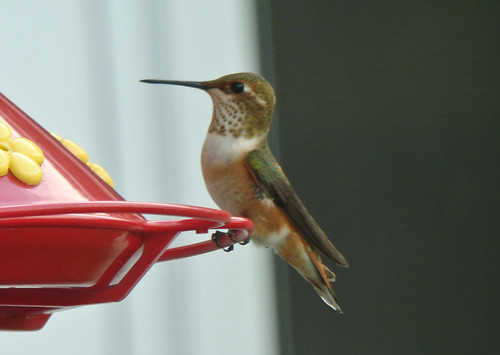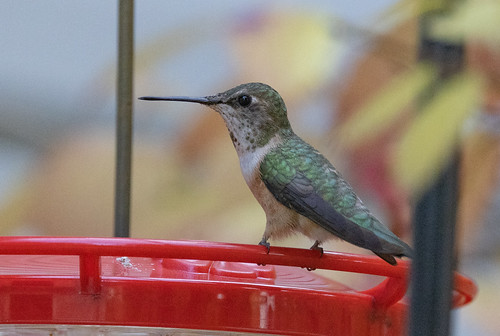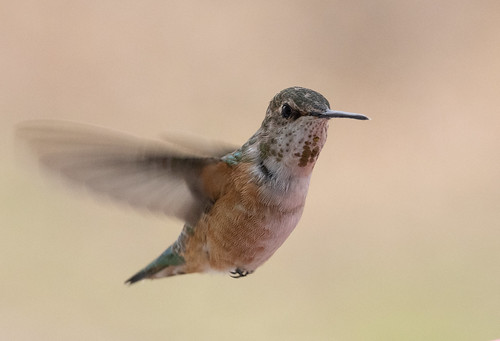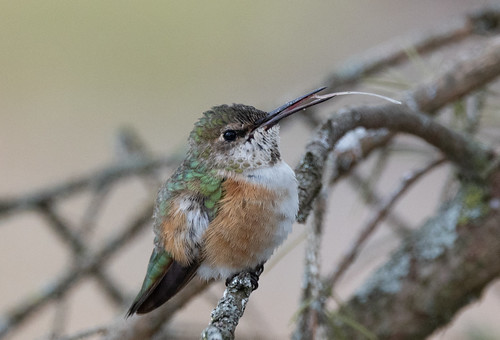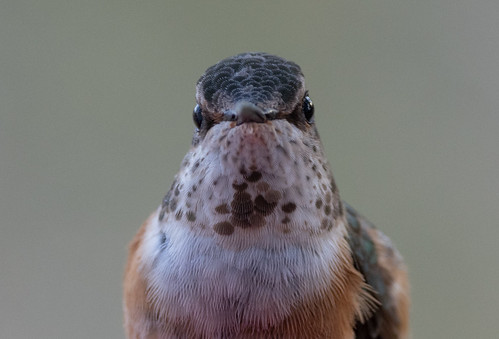When I was a pretty new birder in December 1978, Russ and I went to Texas—he had a meeting in Corpus Christi, and before and after the meeting, he and I went birding to several great spots around the Rio Grande River. When New Years Day 1979 rolled around, I saw the tiniest bird I’d ever seen in my life, a Rufous Hummingbird, at the Santa Ana National Wildlife Refuge.
Back then, I was at that stage intermediate birders go through of being cocksure about our identification abilities, but this didn’t seem at all questionable—my Golden Guide showed only two hummingbirds that ranged in that part of Texas in winter (the area of the map that is blue or purple), the Rufous and Buff-bellied, and Buff-bellied has a bright red bill.
Now we know that hummingbirds do much more wandering than was understood back then, so if this one had been a female, my identification would have been suspect, but fortunately, he was unmistakably a male Rufous Hummingbird, so as I started recognizing some of the trickier possibilities, I never had to reconsider whether he truly belonged on my life list.
I didn’t see another Rufous Hummingbird until 1982, when Russ and I went to Arizona. On April 9, we went to Ramsey Canyon, one of the single best hummingbird viewing spots in the United States, with lots of possibilities for lifers. We got there at 3:30 pm, planning to spend a couple of hours at the feeding station so I could study the different species at leisure, but it turns out they closed the gates at 4 pm, so we had only a half hour there—possibly the most intense 30 minutes of birding I've ever had.
Not all the hummingbirds were lifers—in 1979, I’d seen both Broad-tailed in Estes Park, Colorado, and Calliope at Mount Rainier in Washington, and on this very trip I’d already added four hummingbirds to my life list at other southeastern Arizona hotspots. But Ramsey Canyon was exceptional, and watching so very many hummingbirds zipping this way and that among several feeders was as bewildering as it was fun.
Allen’s and Rufous are both in the genus Selasphorus—some authorities believe the two species should be lumped as one. Females are virtually identical and males are very similar, but Allen’s has more green on the back. The moment I’d for sure seen one male who was clearly all rufous on the back and one with green, I started ignoring both species, trying to get more lifers in the precious minutes I still had before the gates closed. Rufous was just one of many western hummingbirds—very cool, but no more special than any of the others.
In July 2001, Russ and I went on a cruise on a small, Native-owned ship in Alaska’s Inside Passage, and spent a couple of days birding in Juneau before and after the cruise. That’s when I started appreciating that Rufous Hummingbirds are pretty darned hardy—we saw several on that trip.
The very next month, I got to spend a couple of days near New Orleans with Nancy Newfield, one of the finest, most experienced hummingbird banders in the world, which is when I got to see a stunning male Rufous Hummingbird up close and personal. Nancy told me how pugnacious this tiny species is, standing out in a family of pugnacious birds. Rufous, which averages slightly smaller than Ruby-throats, invariably takes over feeders, chasing every other hummingbird off, including significantly larger species. I took a lot of photos for the Journey North educational website.
I didn’t have many opportunities to travel to the West and didn't see another Rufous for over three years, when finally a female took pity. In sort of a reversal of Francis Bacon’s famous “If the mountain will not come to Muhammad, then Muhammad must go to the mountain,” she came to Peabody Street on November 16, 2004. That tiny hummingbird was definitely one of my Top Ten birds of that year. Every day for over two weeks, dozens of birders showed up on Peabody Street to add her to their Minnesota lists and even their life lists. By then, birders were starting to realize that many Rufous Hummingbirds wander east, some being found in Ohio and Pennsylvania, so my bird provided an important data point, but female Rufous are almost identical to female Allen’s Hummingbirds. Allen’s was very unlikely, but the smattering of confirmed records of Allen’s Hummingbirds in the East meant there existed a shadow of a doubt about my hummingbird’s identification, so the Minnesota Ornithologists’ Union Records Committee counted her only as Selasphorus sp.
There was a blizzard on December 2, and temps that night dropped to just 6º, so I got up on December 3 filled with trepidation, expecting to search for her tiny carcass somewhere beneath one of my shrubs or trees, but she was already at my window when I looked out at least a half hour before dawn, so I set out warm sugar water and watched her pig out for a few hours as the temperature rose to the 20s. She lit out for the territory at mid-morning.
I got a job writing a blog for an optics company in 2005, which is when I started taking more bird photos in the field. At first, I was digiscoping—using a small digital camera held in place against my spotting scope, which is how I photographed Rufous Hummingbirds in Mexico in 2006.
In August 2007, I photographed a Selasphorus hummingbird at a feeder in Wisconsin, but couldn’t confirm whether it was a female or a young male, much less a Rufous or Allen’s. The homeowner told me how pugnacious the little bird was, and I watched it chasing off every Ruby-throat.
During my 2013 Big Year, I saw Rufous Hummingbirds in New Mexico, California, and Arizona. As wonderful as my Big Year was, it was also overwhelmingly intense—I did so much traveling to see over 600 species in a single year that many of the individual experiences I had, especially with birds that stayed in view for just seconds, blurred together.
And that was that for my lifetime experiences with Rufous Hummingbirds until just this year. On November 6, my neighbor Jeanne told me that a hummingbird was coming to a feeder down the block. I headed right there and got a few photos. Oddly enough, the species we think of as the only hummingbird in the East, the Ruby-throat, would have been far rarer in November than several western species, and sure enough, this was no Ruby-throat. It was a Selasphorus!
I figured out pretty quickly that like my previous November hummingbird, this was a female. And when she wasn’t visiting feeders, she was spending only a bit of her time resting. She explored every nook and cranny of our neighborhood. Jeanne and I both set up hummingbird feeders in our own yards, and within an hour or so, she discovered both! She came many times every day through December 4, breaking the record for late date of any hummingbird in St. Louis County set by my previous hummingbird. She spent that final day here pigging out, while temperatures were in the 40s but winds were unfavorable for migration. Then an hour or so before sunset, when the winds died down and shifted to the northwest, she lit out for the territory.
During her extended visit, now that I have excellent camera equipment, I took thousands of photos of her through an open window right at my feeder and a nearby tree. I also took pictures and video at a feeder on my front porch—that’s where I got a lovely slo-mo video of her.
From the detailed photos, we figured out that she had to be an adult female Rufous Hummingbird. This time we weren’t simultaneously having a Great Gray Owl invasion so not nearly as many birders were here in Duluth to look at her, but over the four weeks she was here, dozens did show up.
And because I didn’t have an owl invasion to distract me and did have a pandemic to keep me home right when my daughter and son-in-law took my grandson to New York to spend a few weeks, I spent hours every day watching this tiny visitor, really getting to know her.
For me, to know a bird really is to love it—intimate looks at behavior are what grabs me as a birder—and watching this tiny sprite, so unabashed during a couple of snowstorms and a few days when highs barely reached 20º, her pluckiness and sheer hardiness filled me with admiration and abiding love. Of course she's way at the top of my Top Ten list for my best birds of 2021, but she also managed to work herself into a place in my Top Ten Favorite Birds of All Time.









